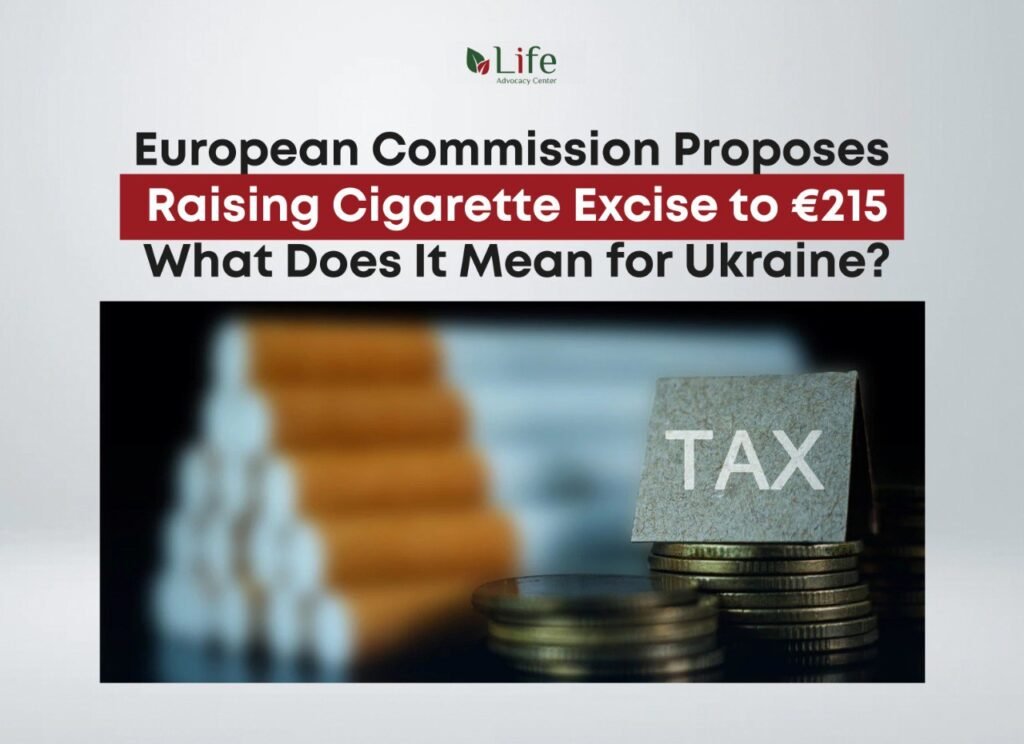The European Commission has published draft amendments to Directive 2011/64/EU on the taxation of tobacco products. The document provides for the revision and harmonisation of minimum excise tax rates on traditional tobacco products, as well as the introduction of mandatory minimum rates for new tobacco and nicotine products appearing on the market. Currently, the average tax rate for cigarettes in EU countries is almost twice the minimum (€90 per 1000 cigarettes).
In addition to Directive 2011/64/EU, amendments are proposed to Directive 2020/262/EU on general arrangements for excise taxes.
Raising minimum tax rates in the EU is necessary to achieve one of the goals of Europe’s Beating Cancer Plan — to create a tobacco-free Europe by 2040, where less than 5% of the population use tobacco, compared to the current 24%.
The new Directive is expected to be adopted by the end of 2025, or, in the worst-case scenario, in the second half of 2026. All 27 EU countries must vote in favour of its adoption, since tax directives are always adopted by consensus.
The revised Directive will apply from 2028. A four-year transition period is planned for the introduction of the new excise tax rates on certain tobacco and nicotine products, which will allow Member States to adapt to these changes.
Proposals to increase excise duty on tobacco and nicotine products
The Commission proposes a partial purchasing power approach to manage price increases in Member States with lower average incomes: 2/3 of the rate will be determined in nominal terms (fixed minimum), and 1/3 will be determined taking into account the purchasing power of the specific Member States (based on the consumer price index). One-third of the minimum excise tax will be revised every three years. This is expected to ensure a more flexible taxation system and adjust for the impact of inflation.
Minimum excise rates on tobacco and nicotine products
| Cigarettes | Tobacco for roll-your-own cigarettes | Cigars | Cigarillos | Other smoking tobacco | Hookah tobacco | Heated tobacco products (HTPs) | Nicotine pouches | |
| Fixed minimum | €215 / 1000 pcs. | €215 / kg | €143 / pc. or kg | €143 / pc. or kg | €143 / kg | €107 / kg | €108 / 1000 pcs. | €143 / kg |
| Relative minimum
(% of weighted average retail price for cigarettes; % of retail price for others) |
63% | 62% | 40% | 40% | 50% | 50% | 55% | 50% |
For liquids used in electronic cigarettes, the European Commission proposes to set the tax rate according to nicotine content: €0.12 per millilitre of liquid with a nicotine level of 0 to 15 mg/ml (20% of the retail price), including liquids not containing nicotine; €0.36 per millilitre with a concentration of nicotine of over 15 mg/ml (40% of the retail price).
The total excise tax must be at least the established percentage of the weighted average retail price. However, Member States that levy an excise tax of €274 per 1000 cigarettes will not be required to comply with the requirement for a total excise duty of 63% of the weighted average retail price.
The updated rates will apply from 2028, but there will be a four-year transition period for products such as cigars, cigarillos, other smoking tobacco, hookah tobacco, nicotine pouches, other nicotine products and heated tobacco products.
What does this mean for Ukraine?
In March 2024, Law No. 4115-IX came into force in Ukraine, introducing a plan to raise excise tax rates on tobacco products until 2028, and to convert the calculation of excise taxes into euros to avoid the impact of devaluation. The plan is to reach a €90 per 1000 cigarettes rate by 2028, which is Ukraine’s European integration commitment, and a rate of €72 per 1000 pcs. for heated tobacco products (a 25% preference compared to cigarettes). A €300 per 1 litre rate has been set for electronic cigarette liquids.
Therefore, according to the current plan, Ukraine will only reach the excise tax rates on tobacco products in line with its current European integration commitments in 2028, while the EU will introduce the new and considerably higher rates in 2028. The current plan to raise excise tax rates is subpar, considering that a meaningful rate increase is expected only in 2025, while 2026-2028 will see excise tax rate increases of 5% and less on cigarettes, and only 0.5% on HTPs. According to an analysis by the Vienna Institute for International Economic Studies (wiiw), this will allow the tobacco epidemic to resurface in Ukraine just after 2026.
Given the strategic goal of Ukraine’s European integration and the European Council’s intentions to significantly raise the minimum excise tax rate, Ukraine’s plan needs to be revised as soon as possible. This way Ukraine can promptly adapt to European standards and prepare for a new phase of tax rate increases in 2028, ensuring effective integration into the EU’s single economic system.
Additionally, Ukraine should return to the effective practice of harmonised taxation of cigarettes and HTPs (cigarettes used with devices such as Ploom, glo, iqos), which will reduce the availability of such products for children and youth while also significantly replenishing the country’s defense budget.
Dmytro Kupyra, program director of NGO Life, notes: “Ukraine currently has two main goals: to preserve statehood and to protect its people. Raising excise taxes will promote both, through preserving the health and lives of Ukrainians, generating significant billions of hryvnias for the country’s defence budget, and bringing Ukraine closer to the EU acquis”.
According to WHO data, raising excise taxes is the most effective way to reduce tobacco use and protect children and youth from becoming addicted to tobacco and nicotine. Note that every year, approximately 100 thousand Ukrainians die prematurely from diseases caused by tobacco consumption, meaning that tobacco is the cause of one in five deaths in Ukraine.
Contact information: Olha Masna, Media Coordinator, NGO Life, 073 089 65 70, olha.masna@center-life.org

